Showing Spotlights 137 - 144 of 315 in category All (newest first):
 Researchers have developed a self-sensing nanotechnology composite material for traffic monitoring by using piezoresistive multi-walled carbon nanotubes as an admixture. In experiments, they studied the response of the piezoresistive properties of this composite to compressive stress and they investigated with vehicular loading experiments the feasibility of using self-sensing CNT/cement composite for traffic monitoring. This nanocomposite cement has great potential for traffic monitoring use such as in vehicle detection, weigh-in-motion measurement and vehicle speed detection. An interesting aspect of this work is that, from the eventual traffic application's point of view, the pavement itself would become the traffic detection, thus eliminating the need for separate traffic flow detection sensors.
Researchers have developed a self-sensing nanotechnology composite material for traffic monitoring by using piezoresistive multi-walled carbon nanotubes as an admixture. In experiments, they studied the response of the piezoresistive properties of this composite to compressive stress and they investigated with vehicular loading experiments the feasibility of using self-sensing CNT/cement composite for traffic monitoring. This nanocomposite cement has great potential for traffic monitoring use such as in vehicle detection, weigh-in-motion measurement and vehicle speed detection. An interesting aspect of this work is that, from the eventual traffic application's point of view, the pavement itself would become the traffic detection, thus eliminating the need for separate traffic flow detection sensors.
Oct 9th, 2009
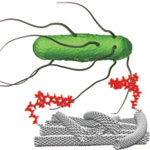 In their effort to develop a fast, sensitive, selective, inexpensive, and easy-to-use method for detecting and quantifying pathogenic bacterial cells, researchers in Spain have now demonstrated a carbon nanotube based potentiometric biosensor for selectively detecting one single colony-forming unit of the bacterium Salmonella Typhi in close to real time. The most important strength of this biosensor is that simple positive/negative tests can be carried out in real zero-tolerance conditions and without cross reaction with other types of bacteria. The ease with which measurements are taken in potentiometric analysis opens the door to greater simplicity in microbiological analysis.
In their effort to develop a fast, sensitive, selective, inexpensive, and easy-to-use method for detecting and quantifying pathogenic bacterial cells, researchers in Spain have now demonstrated a carbon nanotube based potentiometric biosensor for selectively detecting one single colony-forming unit of the bacterium Salmonella Typhi in close to real time. The most important strength of this biosensor is that simple positive/negative tests can be carried out in real zero-tolerance conditions and without cross reaction with other types of bacteria. The ease with which measurements are taken in potentiometric analysis opens the door to greater simplicity in microbiological analysis.
Oct 5th, 2009
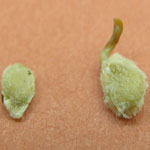 To what degree nanoparticles are uptaken by plants and what their effect is on plant development is an important issue in determining the environmental impact of nanomaterials. Previously we have covered several research projects that have begun to explore nanotechnology's impact on major food crops and some of them have demonstrated quite a negative impact. But some research results also show a possible positive effect, like a recent study that demonstrates that carbon nanotubes (CNTs) can dramatically accelerate the germination and growth of tomato seeds. Work like this contributes to an important body of interdisciplinary research where nanotechnology, plant biology and biotechnology converge to open new perspectives for solving some of the important challenges of our times such as increased food and biofuel production.
To what degree nanoparticles are uptaken by plants and what their effect is on plant development is an important issue in determining the environmental impact of nanomaterials. Previously we have covered several research projects that have begun to explore nanotechnology's impact on major food crops and some of them have demonstrated quite a negative impact. But some research results also show a possible positive effect, like a recent study that demonstrates that carbon nanotubes (CNTs) can dramatically accelerate the germination and growth of tomato seeds. Work like this contributes to an important body of interdisciplinary research where nanotechnology, plant biology and biotechnology converge to open new perspectives for solving some of the important challenges of our times such as increased food and biofuel production.
Sep 29th, 2009
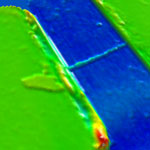 The degree of mobility of a semiconductor, i.e. how well it conducts, is crucial to the effectiveness of nanoelectronic devices. Mobility determines the carrier velocity, and hence switching speed, in FETs. Researchers have determined that the theoretical mobility of an individual single-walled carbon nanotube is about 1000 times higher than any other known semiconductor. However, practical applications would require massive manufacturing of large scale nanoelectronic devices. Despite progress being made with integrating individual nanotubes in lab environments, many of today's nanomanufacturing techniques for nanoelectronic devices rely on the use of 'carbon nanotube network films' comprised of multiple carbon nanotubes. The major problem here is that the electronic properties of CNT network films are usually very poor. Researchers in South Korea have now developed a powerful strategy to solve these fundamental problems simply by controlling the connectivity of nanotube/nanowire networks.
The degree of mobility of a semiconductor, i.e. how well it conducts, is crucial to the effectiveness of nanoelectronic devices. Mobility determines the carrier velocity, and hence switching speed, in FETs. Researchers have determined that the theoretical mobility of an individual single-walled carbon nanotube is about 1000 times higher than any other known semiconductor. However, practical applications would require massive manufacturing of large scale nanoelectronic devices. Despite progress being made with integrating individual nanotubes in lab environments, many of today's nanomanufacturing techniques for nanoelectronic devices rely on the use of 'carbon nanotube network films' comprised of multiple carbon nanotubes. The major problem here is that the electronic properties of CNT network films are usually very poor. Researchers in South Korea have now developed a powerful strategy to solve these fundamental problems simply by controlling the connectivity of nanotube/nanowire networks.
Aug 4th, 2009
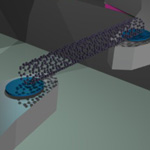 The fundamental issue of large-scale carbon nanotube (CNT) device fabrication remains the biggest challenge for effective commercialization of CNT-based nanoelectronic devices. For CNT electronics to become a reality requires manufacturing techniques to simultaneously and reproducibly fabricate a very large number of such devices on a single chip, each accessible individually for electronic transport. Conventional nanotube growth and device fabrication techniques using chemical vapor deposition or spin-casting are unable to achieve this, due to a lack of precise control over nanotube positioning and orientation. New work conducted at Tel Aviv University utilizes the CVD growth of CNTs over pillar-patterned silicon substrates to facilitate the formation of devices with taut and aligned CNTs grown exclusively at desired positions with built-in electrical contacts.
The fundamental issue of large-scale carbon nanotube (CNT) device fabrication remains the biggest challenge for effective commercialization of CNT-based nanoelectronic devices. For CNT electronics to become a reality requires manufacturing techniques to simultaneously and reproducibly fabricate a very large number of such devices on a single chip, each accessible individually for electronic transport. Conventional nanotube growth and device fabrication techniques using chemical vapor deposition or spin-casting are unable to achieve this, due to a lack of precise control over nanotube positioning and orientation. New work conducted at Tel Aviv University utilizes the CVD growth of CNTs over pillar-patterned silicon substrates to facilitate the formation of devices with taut and aligned CNTs grown exclusively at desired positions with built-in electrical contacts.
Jul 23rd, 2009
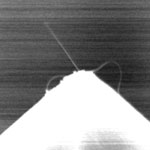 Carbon nanotubes, like the nervous cells of our brain, are excellent electrical signal conductors and can form intimate mechanical contacts with cellular membranes, thereby establishing a functional link to neuronal structures. There is a growing body of research on using nanomaterials in neural engineering. Most studies simply grow carbon nanotubes over microelectrodes to interface with neurons extracellularly. Such an extracellular interface is non-invasive, but it only allows the action potential of neurons to be recorded. In contrast, an intracellular interface allows all of the sophisticated neural activity to be probed, but it is an invasive approach that usually destroys the neuron. Now, new research by scientists in Taiwan is the first to explore the feasibility of using CNTs to probe neural activity intracellularly, opening the way for intracellular neural probes that minimize damage to the neuron.
Carbon nanotubes, like the nervous cells of our brain, are excellent electrical signal conductors and can form intimate mechanical contacts with cellular membranes, thereby establishing a functional link to neuronal structures. There is a growing body of research on using nanomaterials in neural engineering. Most studies simply grow carbon nanotubes over microelectrodes to interface with neurons extracellularly. Such an extracellular interface is non-invasive, but it only allows the action potential of neurons to be recorded. In contrast, an intracellular interface allows all of the sophisticated neural activity to be probed, but it is an invasive approach that usually destroys the neuron. Now, new research by scientists in Taiwan is the first to explore the feasibility of using CNTs to probe neural activity intracellularly, opening the way for intracellular neural probes that minimize damage to the neuron.
Jul 22nd, 2009
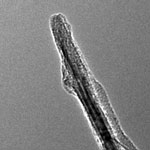 Carbon nanotubes have long been recognized as a promising material for the storage of hydrogen. Back in 2003, researchers first synthesized carbon nanoscrolls - another carbon nanomaterial similar to multi-walled carbon nanotubes - that was reported to be promising for hydrogen storage. Carbon nanoscrolls (CNS) can be obtained by rolling up a graphene sheet into a tubular structure. In contrast to multi-walled carbon nanotubes, with CNS one can vary the distance between layers, a property that might be crucial for gas storage applications. CNS are also expected to be useful in other applications, for instance in nanoelectronics, since they inherit some properties from both graphene and carbon nanotubes, e.g. high mechanical strength and carrier mobility. However, theoretical calculations also predict some unusual electronic and optical properties of CNS due to their unique topology. Previously, several methods have been developed to make CNS. However, they were hard to control, difficult to purify, and the fabricated scrolls were found to possess poor morphology. Now, researchers in Beijing have developed a simple and effective technique for fabricating high-quality CNS.
Carbon nanotubes have long been recognized as a promising material for the storage of hydrogen. Back in 2003, researchers first synthesized carbon nanoscrolls - another carbon nanomaterial similar to multi-walled carbon nanotubes - that was reported to be promising for hydrogen storage. Carbon nanoscrolls (CNS) can be obtained by rolling up a graphene sheet into a tubular structure. In contrast to multi-walled carbon nanotubes, with CNS one can vary the distance between layers, a property that might be crucial for gas storage applications. CNS are also expected to be useful in other applications, for instance in nanoelectronics, since they inherit some properties from both graphene and carbon nanotubes, e.g. high mechanical strength and carrier mobility. However, theoretical calculations also predict some unusual electronic and optical properties of CNS due to their unique topology. Previously, several methods have been developed to make CNS. However, they were hard to control, difficult to purify, and the fabricated scrolls were found to possess poor morphology. Now, researchers in Beijing have developed a simple and effective technique for fabricating high-quality CNS.
Jul 20th, 2009
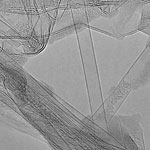 A few days ago we ran a Nanowerk Spotlight on a nanostructuring technique that uses an extremely narrow electron beam to knock individual carbon atoms from carbon nanotubes with atomic precision, a technique that could potentially be used to change the properties of the nanotubes. In contrast to this deliberately created defect, researchers are concerned about unintentional defects created by electron beams during examination of carbon nanomaterials with transmission electron microscopes like a high-resolution transmission electron microscope (HRTEM). For a long time it has been thought that if the accelerating voltage of electrons could be reduced to 80 kV in an electron microscope, then the electrons would not possess sufficient energy to cause knock-on damage in carbon nanomaterials. Knock-on damage occurs when electrons are scattered by the nucleus of the atom they are probing. Upon scattering, energy is transferred. In some circumstances this energy can be large enough to dislodge the atom from its position. A British-German team has examined how electrons accelerated at 80 kV interact with singe-walled carbon nanotubes and shown that in some circumstances SWCNTs were unstable.
A few days ago we ran a Nanowerk Spotlight on a nanostructuring technique that uses an extremely narrow electron beam to knock individual carbon atoms from carbon nanotubes with atomic precision, a technique that could potentially be used to change the properties of the nanotubes. In contrast to this deliberately created defect, researchers are concerned about unintentional defects created by electron beams during examination of carbon nanomaterials with transmission electron microscopes like a high-resolution transmission electron microscope (HRTEM). For a long time it has been thought that if the accelerating voltage of electrons could be reduced to 80 kV in an electron microscope, then the electrons would not possess sufficient energy to cause knock-on damage in carbon nanomaterials. Knock-on damage occurs when electrons are scattered by the nucleus of the atom they are probing. Upon scattering, energy is transferred. In some circumstances this energy can be large enough to dislodge the atom from its position. A British-German team has examined how electrons accelerated at 80 kV interact with singe-walled carbon nanotubes and shown that in some circumstances SWCNTs were unstable.
Jun 25th, 2009
 Researchers have developed a self-sensing nanotechnology composite material for traffic monitoring by using piezoresistive multi-walled carbon nanotubes as an admixture. In experiments, they studied the response of the piezoresistive properties of this composite to compressive stress and they investigated with vehicular loading experiments the feasibility of using self-sensing CNT/cement composite for traffic monitoring. This nanocomposite cement has great potential for traffic monitoring use such as in vehicle detection, weigh-in-motion measurement and vehicle speed detection. An interesting aspect of this work is that, from the eventual traffic application's point of view, the pavement itself would become the traffic detection, thus eliminating the need for separate traffic flow detection sensors.
Researchers have developed a self-sensing nanotechnology composite material for traffic monitoring by using piezoresistive multi-walled carbon nanotubes as an admixture. In experiments, they studied the response of the piezoresistive properties of this composite to compressive stress and they investigated with vehicular loading experiments the feasibility of using self-sensing CNT/cement composite for traffic monitoring. This nanocomposite cement has great potential for traffic monitoring use such as in vehicle detection, weigh-in-motion measurement and vehicle speed detection. An interesting aspect of this work is that, from the eventual traffic application's point of view, the pavement itself would become the traffic detection, thus eliminating the need for separate traffic flow detection sensors.
 Subscribe to our Nanotechnology Spotlight feed
Subscribe to our Nanotechnology Spotlight feed





